What's inside
What's inside
 Benefits
Benefits

 Concerns
Concerns

No concerns
 Ingredients Side-by-side
Ingredients Side-by-side

Colloidal Oatmeal Extract
HumectantBehentrimonium Chloride
PreservativeCetyl Alcohol
EmollientCetearyl Alcohol
EmollientGlycerin
HumectantPPG-3 Benzyl Ether Myristate
EmollientSteareth-20
CleansingRubus Villosus Fruit Extract
AstringentHydrolyzed Quinoa
Skin ConditioningAmodimethicone
Polyquaternium-47
Skin ConditioningPolyquaternium-37
PPG-1 Trideceth-6
Skin ConditioningPropylene Glycol Dicaprylate/Dicaprate
EmollientWater
Skin ConditioningIsopropyl Alcohol
SolventDisodium EDTA
Citric Acid
BufferingSodium Hydroxide
BufferingSodium Benzoate
MaskingParfum
MaskingColloidal Oatmeal Extract, Behentrimonium Chloride, Cetyl Alcohol, Cetearyl Alcohol, Glycerin, PPG-3 Benzyl Ether Myristate, Steareth-20, Rubus Villosus Fruit Extract, Hydrolyzed Quinoa, Amodimethicone, Polyquaternium-47, Polyquaternium-37, PPG-1 Trideceth-6, Propylene Glycol Dicaprylate/Dicaprate, Water, Isopropyl Alcohol, Disodium EDTA, Citric Acid, Sodium Hydroxide, Sodium Benzoate, Parfum
Ingredients Explained
These ingredients are found in both products.
Ingredients higher up in an ingredient list are typically present in a larger amount.
Glycerin is already naturally found in your skin. It helps moisturize and protect your skin.
A study from 2016 found glycerin to be more effective as a humectant than AHAs and hyaluronic acid.
As a humectant, it helps the skin stay hydrated by pulling moisture to your skin. The low molecular weight of glycerin allows it to pull moisture into the deeper layers of your skin.
Hydrated skin improves your skin barrier; Your skin barrier helps protect against irritants and bacteria.
Glycerin has also been found to have antimicrobial and antiviral properties. Due to these properties, glycerin is often used in wound and burn treatments.
In cosmetics, glycerin is usually derived from plants such as soybean or palm. However, it can also be sourced from animals, such as tallow or animal fat.
This ingredient is organic, colorless, odorless, and non-toxic.
Glycerin is the name for this ingredient in American English. British English uses Glycerol/Glycerine.
Learn more about GlycerinWater. It's the most common cosmetic ingredient of all. You'll usually see it at the top of ingredient lists, meaning that it makes up the largest part of the product.
So why is it so popular? Water most often acts as a solvent - this means that it helps dissolve other ingredients into the formulation.
You'll also recognize water as that liquid we all need to stay alive. If you see this, drink a glass of water. Stay hydrated!
Learn more about Water